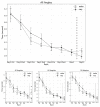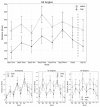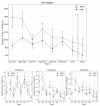Potential Benefits of Daytime Naps on Consecutive Days for Motor Adaptation Learning
- PMID: 36134945
- PMCID: PMC9497798
- DOI: 10.3390/clockssleep4030033
Potential Benefits of Daytime Naps on Consecutive Days for Motor Adaptation Learning
Abstract
Daytime napping offers benefits for motor memory learning and is used as a habitual countermeasure to improve daytime functioning. A single nap has been shown to ameliorate motor memory learning, although the effect of consecutive napping on motor memory consolidation remains unclear. This study aimed to explore the effect of daytime napping over multiple days on motor memory learning. Twenty university students were divided into a napping group and no-nap (awake) group. The napping group performed motor adaption tasks before and after napping for three consecutive days, whereas the no-nap group performed the task on a similar time schedule as the napping group. A subsequent retest was conducted one week after the end of the intervention. Significant differences were observed only for speed at 30 degrees to complete the retention task, which was significantly faster in the napping group than in the awake group. No significant consolidation effects over the three consecutive nap intervention periods were confirmed. Due to the limitations of the different experimental environments of the napping and the control group, the current results warrant further investigation to assess whether consecutive napping may benefit motor memory learning, which is specific to speed.
Keywords: consolidation; learning; motor adaptation; nap; sleep.
Conflict of interest statement
The authors declare no conflict of interest.
Figures





References
LinkOut - more resources
Full Text Sources
Research Materials

